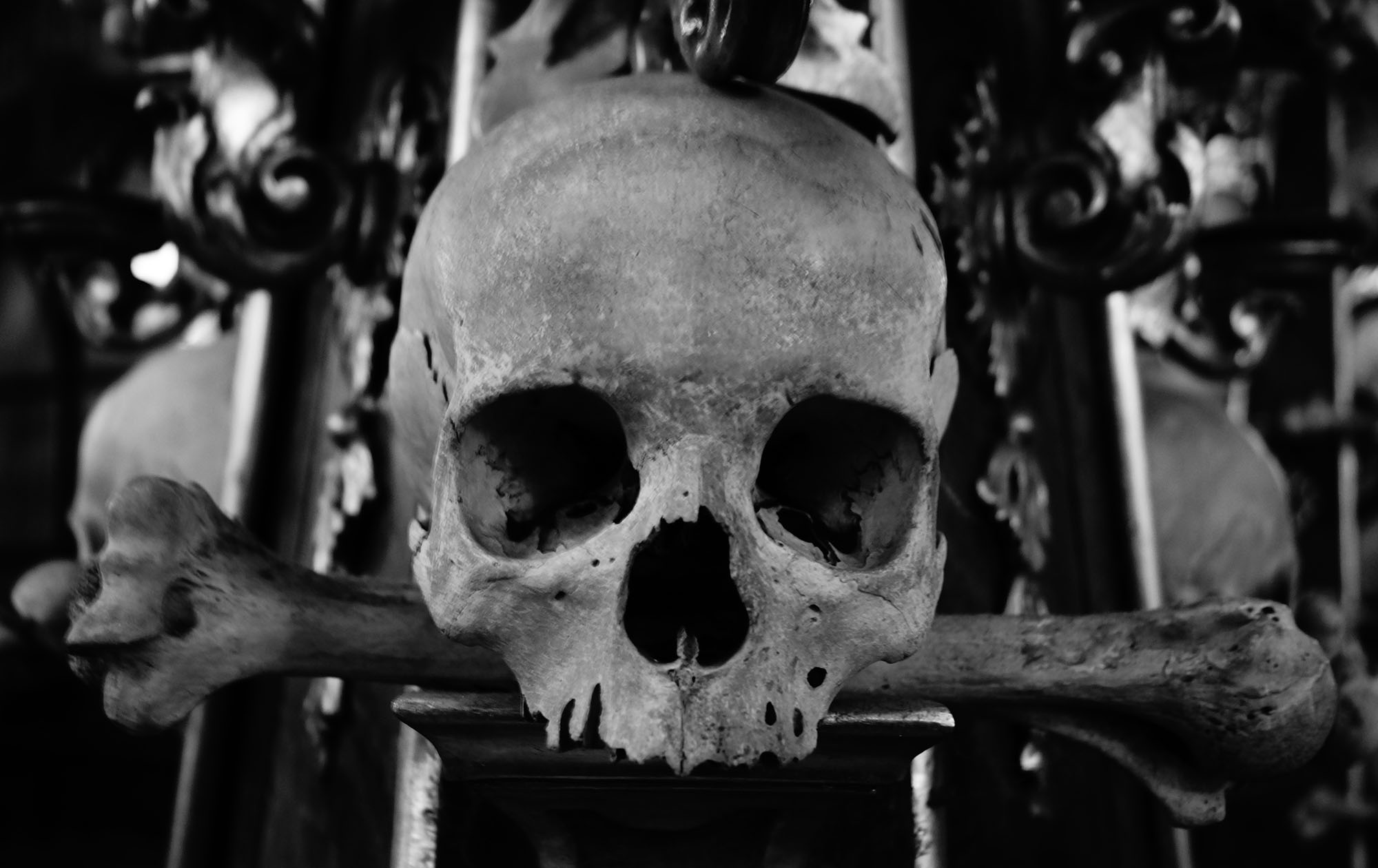The name of the game is collateral damage! USA Today Bestselling Author and ENnie Award-winning RPG designer Justin Alexander shows you how to get a little sloppier with your aim: Don’t just hit the PCs. Start hitting stuff all around them. Their friends, their allies, innocent bystanders, even their enemies.
Archive for the ‘Roleplaying Games’ category
Advanced Gamemastery: Spray Your Bullets
Running Mysteries – Proactive Nodes
A completely reactive mystery — in which the characters simply explore scenes, discover leads, and follow those leads to new scenes (and then repeat) — can make for a perfectly lovely scenario.
With that being said, when you’re designing a mystery scenario, I strongly recommend including proactive nodes: Stuff that can (and will!) come to find the PCs even if they’re standing still. These elements put the world in motion, implying that the world exists and things are happening beyond what the PCs can immediately see. Even the lightest spicing of these elements can add a ton of dynamic life to a scenario.
These proactive elements don’t necessarily need to be (or, more accurately, contain) clues, but in a mystery scenario why would you pass up the opportunity?
This, in turn, makes proactive nodes the single best troubleshooting tool you can have when running a mystery. As discussed in the Three Clue Rule, if you end up in a situation where the players are stuck, dithering, or have decided to hide from the adventure, you can simply trigger a proactive node to bring the next scene to the PCs and keep the adventure moving forward.
But troubleshooting isn’t the only reason to trigger a proactive node.
Another option is to advance the timeline. This assumes that the antagonists in the scenario are actively pursuing an ongoing agenda (e.g., another bank is robbed; the serial killer targets another victim; the Death Star blows up another planet). You simply trigger the next step in their plan (or the next stage of the parasite’s life cycle).
The trick, however, is that the bad guys’ plan may have nothing to do with the PCs, and the next stage of the plan may happen completely offscreen without the PCs being aware of it. What you want to do, therefore, is to think not only about what happens, but also how those events end up intersecting the PCs.
This maybe straightforward. For example, if the PCs are FBI agents investigating the serial killer, then their boss can simply contact them and send them to the new crime scene. If they’re superheroes pursuing high-tech bank robbers, on the other hand, you might want to have them spot the robbery in progress while they’re patrolling the streets or, alternatively, they could spot a news broadcast mentioning the most recent crime.
Along similar lines, you can also raise the stakes. For example, the bad guys have finished building their death ray and now they start using it. Or the parasite begins transforming the residents of Evergrove into horrible monsters.
Proactive nodes can also be used to create consequences: Did the PC super-spies tip their hands and let Le Élcarlate know they were investigating him? Then it makes sense that he’d send some thugs to dissuade them! (Or a femme fatale to seduce them.)
This technique can work even if the players are clueless about what they did to earn the payback. (“Well… we clearly pissed somebody off.”) But it’s usually even more effective if they can see the connection between what they did and the proactive node that landed in their lap. It reinforces that their choices are meaningful, as are the repercussions of their successes and failrues. (If it’s unclear, you might consider including some clues or hints to help them figure out why the fish-people suddenly tried to blow up their hotel room.)
You might also employ proactive nodes simply for pacing. Are the players getting a little listless? Does the session seem to be lagging a bit? Nothing a squad of android assassins can’t fix!
TIME PASSES
Something I’ve discovered is that proactive nodes work best when the players have a clear sense of time passing in the game world.
There can be a tendency in an RPG for stuff to just kind of happen, one thing after another after another, in a sort of amorphous temporal void. It can be surprisingly easy for an adventure to start in the late afternoon and then have the PCs do eighteen different things, drive back and forth multiple times across town, and yet never have the day come to an end.
When you get stuck in this timeless state, it can become difficult to properly trigger a proactive node. (“If it’s only been an hour so since they found the body, does it really make sense that the bad guys could figure out where they lived and planted explosives there?”) And consequences can also feel capricious instead of consequential.
This can also be true if things become untacked in time: If it feels like only a few hours have passed, it can feel unfair or unhinged when a proactive event suddenly reveals that days have passed.
What you need is both a clear internal sense of how much time is passing for the characters and to clearly communicate that to the players so that their mental image of the game world is accurate.
For the first part, what I find useful is a mental model that roughly divides the day into four parts:
- Morning
- Afternoon
- Evening
- Overnight
(If the PCs are particularly active at night, you can also split that into two parts.)
Generally speaking, the PCs can each do one thing in each “slot” of the day. When they change location or tackle some completely new and time-consuming task, you can move things forward to the next slot. (If any PCs haven’t done something in the current slot, this is also a good time to ask them what they were doing while “Bob spends the afternoon at the library” or whatever.)
All you need to do now is communicate that passage of time to the players. Fortunately, you don’t need to make a big deal out of this. In fact, asking, “What are the rest of you doing while Bob spends the afternoon at the library?” neatly takes care of the problem. You can also make a point of including time of day when describing new scenes: “As you pull into the hotel parking lot, the sun is setting…” or “When you reach Aunt Cass’ house, she’s in the kitchen making lunch for the kids…”
Collectively, this temporal awareness will give a concrete sense of structure to the events happening in the game world; it’ll help you balance spotlight time; it’ll impose a sense of urgency in the players (even if there’s no clear time pressure); and it’ll let you naturally slot in your proactive events.
Frankly, it’s just good praxis in general.
CRAFTING PROACTIVE NODES
Our discussion of proactive nodes has mostly focused on various forms of trouble: A crisis happens. The bad guy’s do something horrible. A guy with a gun walks through the door.
But proactive nodes can also be opportunities. In fact, probably the most ubiquitous form of proactive scene is the scenario hook at the beginning of an adventure: The PCs are minding their own business when they see a damsel in distress. Or a patron offers them a job.
A key insight is that these kinds of opportunities can also be offered in the middle of an adventure: A local gangbanger hears the PCs have been looking into the recent disappearances, so when her friend goes missing she comes to the PCs hoping they can help. Or maybe the antagonist decides it would be cheaper to offer the PCs a payoff to go mind their own business.
(If you’re running a more complicated campaign structure in which scenarios can overlap with each other, you might even have situations where the players don’t immediately realize that the new offer is connected to the ongoing scenario.)
What if you’re in the middle of a session, discover that you need a proactive node to get things back on track, and then realize that you don’t have one?
You can improvise something, of course, but it may also be possible to repurpose a static node.
For example, maybe the PCs were supposed to track down the safe house where the vampires are keeping a bunch of blood-addicted Renfields. Now they’ve pissed off the vampires enough that it would seem to demand a response… so why not grab some or all of those Renfields and throw ‘em at the PCs?
The all-purpose version of this, for scenarios that have gone completely imploded, is to just have the Big Bad Guy show up wherever the PCs happen to be and trigger the final showdown. In practice, of course, this is insanely unsatisfying for the players. You’re almost always going to be better off using a proactive node loaded up with clues that point the PCs to the Big Bad Guy (wherever they might be), so that the players will have the satisfaction of “figuring it out.” (This is, ultimately, a form of Matryoshka technique.)
Rope Trick: Beyond Gray Walls
The spell was cast, and just in time. You and your friends were in dreadful need of respite, and you gratefully climbed up the rope and through the unseen portal.
Now you’re huddled in a small, featureless room of stone that has been conjured into some proto-dimensional pocket by your party’s sorcerer. A single small window looks out into the material plane.
And then, in the middle of the night, you hear something…
…tap. tap. tap.
A tapping on the wall.
…tap. tap. tap.
From the far side of the wall.
…
After a few minutes it stops.
Maybe you panic and drop out of the rope trick. Maybe you stick it out until morning. But that’s it.
For now.
But the next time you crawl up into a rope trick (or maybe it’s the time after that)…
…tap. tap. tap.
…tap. tap. tap.
When the tapping stops, maybe you listen at the walls. Is that whispering you hear?
And then, whether it’s after hours or days, the tapping comes again. And it goes on longer this time. It lasts for several minutes, and then — BAM!
Something on the far side slams into the walls of the rope trick hard enough to make the whole thing shake. Maybe the window back to the real world cracks.
There’s no question now. Something out there is hunting you. And what, exactly, is beyond these inert little gray walls of seeming sanctuary?
Maybe you decide to dig out. Maybe something digs in. Maybe the next time you come up into the rope trick you find a neat little hole burrowed into the wall.
If you’re looking for inspiration on what might lie beyond the rope trick, Mark Z. Danielewski’s House of Leaves seems like it might be a good place to start.
The Layered Hexcrawl – Part 2: Pointcrawl Layers
A much more literal “layer” you can use in conjunction with a hexcrawl is a pointcrawl. You can actually imagine a hexmap and a pointmap both being used to depict the exact same swath of the game world.
But since hexcrawls and pointcrawls are both designed to handle geographic movement through an environment, why would you want to do this? Wouldn’t it just be redundant?
Not exactly, because hexcrawls and pointcrawls both look at the environment in different ways and specialize in handling different types of movement. A hexcrawl allows freeform movement in any direction, while a pointcrawl organizes the world into specific paths between points.
You can perhaps appreciate the distinction most clearly by looking at roads & trails.
While it’s certainly possible to resolve travel along a road using the procedures of a hexcrawl, in practice I’ve found that it can be quite awkward. In a typical hexcrawl procedure, there’s all kinds of decision points and resolution points that become redundant or overly complicated when the PCs are following a road. (For example, the PCs can’t really become lost.) Tracking progress through a hex while traveling by road is more fiddly than it needs to be, and also calls attention to the fact that the rigid specificity of the road is at conflict with the abstract nature of the hex. Even referencing hex keys along the road is more complicated than it needs to be.
Meanwhile, the types of decisions the players (and their characters) are going to naturally start wanting to make while traveling along a road are quite different from the decisions they’ll want to make while exploring freely through the wilderness. This creates a mismatch between the actions they’re declaring and the choices you need them to make in order to resolve the hexcrawl procedure.
In short, you’ll find yourself frequently fighting the procedure rather than using it.
THE ROAD MAP
So as you’re prepping your hexcrawl, you may want to take the time to prep a pointcrawl of the region, with a pointmap detailing all the major roads and trails. In my experience, you’ll also want to include the major rivers, since it’s quite common for PCs to use these as navigational paths.
These roads, rivers, and trails will likely also appear on your hexmap, of course, and give you the freedom to resolve travel along using either the procedures of the hexcrawl or pointcrawl, whichever one seems most appropriate and useful at any given moment.
In fact, I would do everything possible to keep these two layers in sync with each other.
If you’re starting from a hexmap, refer to the hex key as you set up the pointcrawl and:
- Make sure to include every On Road / On River encounter located along the path.
- Check for Visible landmarks that aren’t technically on the path, but would be seen while traveling along it. It’s quite likely that these should be included as points on your pointmap.
You probably don’t need to think about the mountains visible to the north while traveling along the Old Keep Road, but “midway between Northpoint and the crossroads you can see the ruins of an old lighthouse on an island off the coast” is a milestone you’ll want to mention.
Conversely, if/when you end up adding new points to your pointmap, you’ll usually want to make sure they also get added as On Road locations in your hex key.
BESPOKE PATHS
On that note, during actual play in your hexcrawl, your players will very quickly begin forging bespoke paths through the wilderness.
Sometimes this will be a deliberate action, which is what the trailblazing rules are for: The PCs are specifically marking paths with trail signs so that they can follow them later.
But it’s even more common for de facto paths to emerge during play: To get to the Violet Halls, we head east from Maernath until we hit the river, then follow the river southeast into the Gloomboughs until we reach the island with the standing stone. From there we turn due south towards the mountains until we reach the broken stone gate.
If you learn to recognize these bespoke paths as they emerge and add them to your pointmap, you’ll make life much easier for yourself. By resolving the journey as a prepared path, you’ll be able to much more efficiently and effectively resolve these trips through known territory, and spend more time pushing ever deeper into the Violet Halls.
(And, of course, if the PCs ever get lost along the way, you can be bounce back into the hexcrawl procedure and begin figuring out where they end up.)
In some cases, you may also discover that these bespoke paths fade away again (e.g., when the PCs have finished exploring the Violet Halls, the path they followed to get there stops being relevant). If so, and if you find your pointmap getting a little too crowded, there’s nothing wrong with pruning these paths away so that you can focus on what’s relevant.
(I do recommend archiving pruned paths somewhere that you can find them again, though. You never know when the PCs might suddenly decide to return to the Violet Halls.)
OTHER POINTCRAWL LAYERS
Pointcrawls are an incredibly versatile scenario structure, so it probably won’t surprise you to discover that there are more ways to use them in conjunction with a hexcrawl than simply an alternative navigation layer.
For example, consider an underdark tunnel system that links various dungeons keyed to your hexmap, but which can also be used to reach deeper and even more dangerous locations.
Pointcrawls can also be very useful for subhex navigation, which will be the topic of another addendum.
Ptolus: Running the Campaign – Using Scenery & Traps

DISCUSSING
In the Shadow of the Spire – Session 39A: Chamber of Bone
Tee felt the ratlings throw their weight against the door, but she was able to hold it against their charge.
Tee signaled for the others to back up out of the chamber of bone, bracing the door against another pounding from the ratlings on the other side. Then she jumped back herself and, as the ratlings charged through, shot out the pillars of bone.
A cascade of bone collapsed. Several of the ratlings, pouring into the room, were struck about the heads and shoulders; one was even knocked unconscious by a particularly heavy chunk of pelvis. Others slipped and tripped, their feet turned treacherously by the shifting mass beneath their feet.
In Rulings in Practice: Traps, I said that you’ll know you have the balance right when the players start harvesting supplies from the traps or finding other ways of turning them to their advantage. In practice, this is probably a specific application of a wider principle: The more time players spend creatively interacting with stuff in the game world, the more you’ll know that (a) you’re succeeding in including cool stuff that’s bringing the world to vivid life and (b) that you’ve got great players.
Conversely, if you’re a player, pay attention to your character’s surroundings and look for opportunities to turn them to your advantage.
In this case, my players were very on top of things. Here’s what the key for this room looked like:
AREA 8 – BONE CHAMBER
The walls of this chamber are stacked high with bones — human bones. They have been arranged in intricate and detailed patterns with an effect which is entirely ghastly. Four pillars of interlocking skulls and femus reach from the floor to the ceiling.
Handout: The Bone Chamber
Bone Pillars: Any blow to one of these pillars (AC 3) will cause it to collapse, causing a cascade of bone. Characters within 5 ft. of the pillar must make a Reflex save (DC 15). On a failure, they are dazed and must make a Fortitude save (DC 12) to avoid being stunned.
Swinging Weapons: Characters who swing weapons within range of a bone pillar must succeed on a Reflex save (DC 10) to avoid striking the pillar. Alternatively, they can carefully avoid the pillar while making their attack — this requires no saving throw, but does impose a -2 penalty to their attack rolls.
(This room was inspired by the Sedlec Ossuary. The handout consisted of photos from the actual ossuary, which you can see in the linked campaign log.)
In addition to just being a creepy room, I’d intended for the ratlings to take advantage of the environmental hazard. The PCs, however, were savvy enough to be suspicious of the ones, realize they were precarious, and then almost immediately turn the situation to their own advantage.
In this case, the idea of the bone piles being precarious had occurred to me during prep. But the key thing is just including the bone piles as set dressing in the first place. Even if I didn’t have an answer prepped, a nigh identical scene could have emerged simply from the players asking, “Do the piles look unstable?”
Of course, it’s not just the bone stacks they’re using here. They start by using the door to control the start of the campaign, giving them time to estalblish their tactical position (as we’ve also discussed in Running the Campaign: Battles at the Door). And then, at the end of the fight, Agnarr rips the crossbow bolts out of his shoulder and uses them as improvised weapons!
When you fill your description of the world with interesting details, you’re providing the raw ingredients. Once you’ve done that, it become very easy for the whole group to start cooking.
Campaign Journal: Session 39B – Running the Campaign: Clues Linking Scenarios
In the Shadow of the Spire: Index
Archives
Recent Posts
- Alexandrian Auxiliary – Reading D&D Aloud
- Random GM Tip – Character Sheet Logistics
- Review: Mothership Adventure Sphere – Part 5: Airlock Series
- Ptolus: Running the Campaign – Undead for Effect
- In the Shadow of the Spire – Session 48C: Entering the Tomb
Recent Comments
- on Review: Mothership Adventure Sphere – Part 4
- on Ptolus: Running the Campaign – Undead for Effect
- on Random GM Tip – Character Sheet Logistics
- on Why Voodoo Economics Don’t Work: The Quick and Dirty Version
- on Random GM Tip – Character Sheet Logistics
- on In the Shadow of the Spire – Session 48C: Entering the Tomb
- on Random GM Tip – Character Sheet Logistics
- on Review: Mothership Adventure Sphere – Part 5: Airlock Series
- on D&D: Designing Backwards
- on Random GM Tip – Character Sheet Logistics














